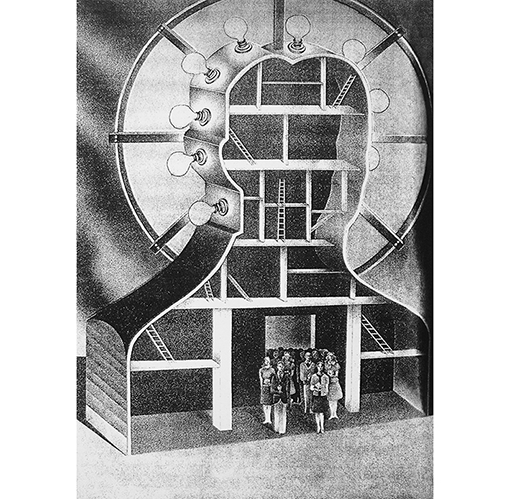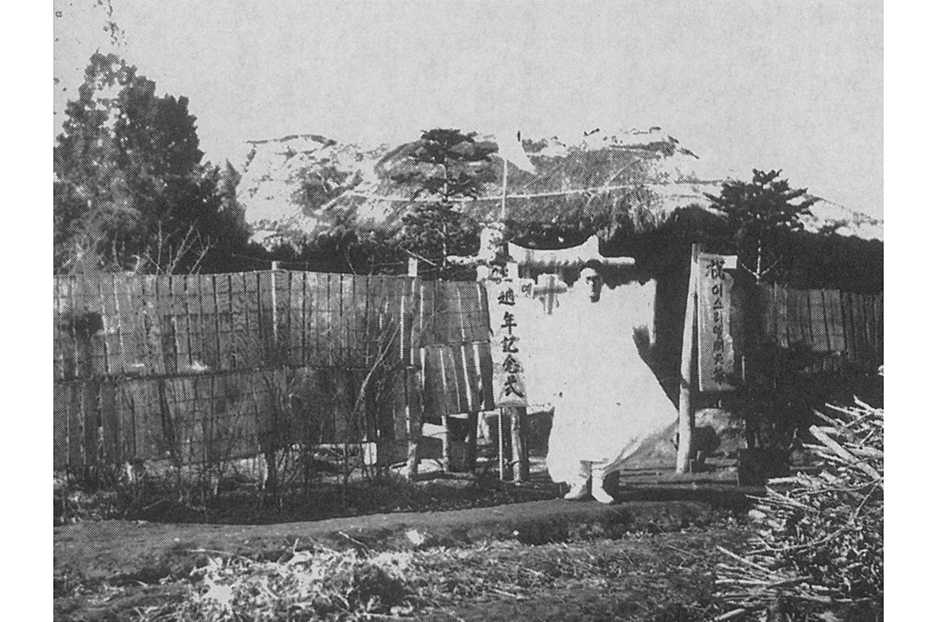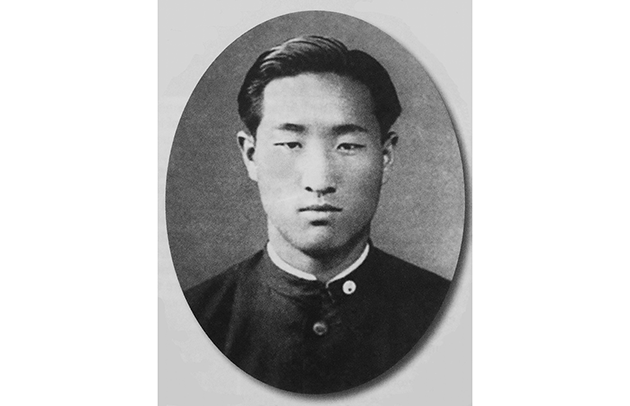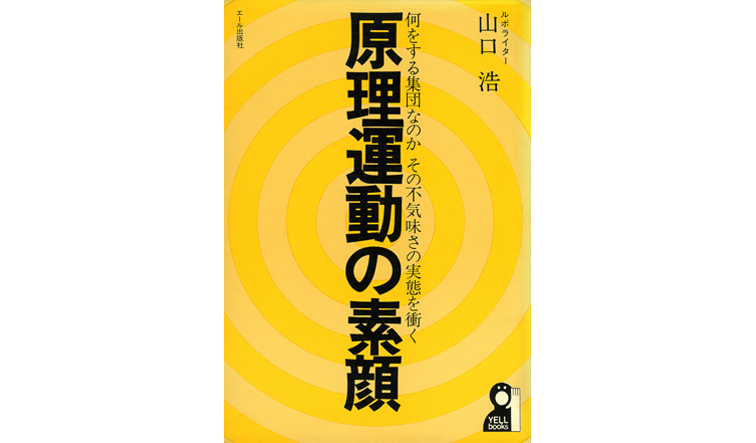Contents
1. The Unification Church of Sun Myung Moon by Jane Day Mook
in A.D. (May 1974)
2. A quote from “From Korea with Love” by John D. Marks
extract from The Washington Monthly (February 1974)
3. Sun Myung Moon said he went to Waseda University in Tokyo in 1941-1943
4. Evidence that Sun Myung Moon NEVER went to Waseda University
– Hiroshi Yamaguchi investigates in his 1975 book.
7. Footnote: Notes from Dan Fefferman
Note: Photographs have been added
1.
A.D. magazine May 1974 pages 30-36
New Growth on Burnt-Over Ground
Third in an A.D. series offering a critical look at new religions in America.
The Unification Church of Sun Myung Moon
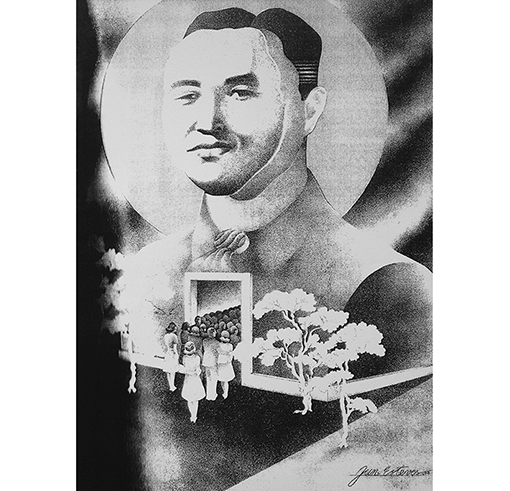
Hope and fear are almost always entwined in the impulses that cause a man or woman to seek a faith. Therefore it is not strange that religions contain promises both of divine intervention or mercy, and of judgment. Thus, Judaism speaks of a messiah and an apocalypse, the faithful of Islam expect a delivering mahdi and a terrible, bright-sworded angel, and some Christian Scriptures indicate that Christ will summon saints to glory and the wicked to perdition on a future Day of the Lord. Even among the new religions now sprouting on the burnt-over earth of American religious life, the notes of hopeful expectation and dread of doom are sounded. Religious leaders arise, and are examined by their followers: Are you he (or she) who will deliver us? And almost always a direct answer is avoided in replies that sound strangely like, “Who do men say that I am?” Today, in many areas of America, people are asking a middle-aged Korean named Sun Myung Moon who he is. Writer Jane Day Mook, in six months of extensive research, has come up with some of the answers.
There has been a rash of headlines:
Korean Preacher Urges U.S. Not to “Destroy President”
Minneapolis Star, December 1, 1973
Watergate Day of Prayer Asked by Unification Church
Washington Post, December 18, 1973
Unification Church Program Under Way in Houston
Religious News Service, December 27, 1973
There have been other media reports:
█ On December 26, 1973, Congressman Guy Vander Jagt of Michigan read into the Congressional Record a statement by the Reverend Sun Myung Moon of Korea, founder of the Unification Church International, urging Americans to forgive, love, unite.
█ Governor Wendell Anderson of Minnesota and Mayors Charles Stenvig and Larry Cohen of Minneapolis and St. Paul, respectively, issued proclamations saluting Moon when he visited the Twin Cities in December last year.
█ Twelve hundred supporters of Moon turned out—with specially issued tickets (100 of them for the best seats up front) — to cheer President Nixon at the national Christmas tree lighting ceremony at the White House on December 13, 1973. They carried signs saying, “God loves Nixon,” “Support the President,” and quite simply, “God.” Afterward, when the President came to greet them in Lafayette Park, one writer reports, they knelt down as he drew near.
█ Six weeks later Moon was invited to the 22nd annual National Prayer Breakfast in the Washington Hilton Hotel. While it was going on, more than 1,000 of Moon’s followers gathered to sing patriotic songs and demonstrate their support of the President. Tricia Nixon Cox and her husband walked among the disciples and spoke with Neil Salonen, national head of the Unification Church.
█ The next day, Moon had an unscheduled meeting with President Nixon. He embraced the President and then, it is reported, “prayed fervently in his native tongue while the President listened in silence.” Before leaving, Moon exhorted the President not to knuckle under to pressure but to stand up for his convictions.
What is this all about? Who is this Korean religious leader, Sun Myung Moon, who reaches the eye of those in high office, including the President himself?
What is this Unification Church that has suddenly surfaced in the United States with so much noise and splash? Is it really a Christian church? Is its aim political or religious, or both?
The Unification Church (whose full name is The Holy Spirit Association for the Unification of World Christianity) found its way into the consciousness of a few Americans about 15 months ago. In Tarrytown, New York, a gracious estate of 22 acres overlooking the Hudson River quietly changed hands for $850,000. [Price confirmed by Mickler in History of the UC in the US.] “Belvedere” became a center for the Unification Church.
Korean messiah? Christ of the second advent? Young Americans find new faith and new life in following him.
—
Joyous, disciplined, loving, Moon’s young followers express the confidence of the deeply committed.
Suddenly the residents of Tarrytown discovered that, because this is a “church” and therefore tax exempt, they had lost $8,000 in city taxes. They discovered, too, that by the summer of 1973 the estate was teeming with young people—Japanese, Korean, German, Austrian, and especially British.
The British—115 of them—came in response to ads posted on their college bulletin boards: New York and back for $25 and a summer of “leadership training” to boot. But the Belvedere mansion was not adequate. Crowding was dismal, regulations and restrictions irksome, morale bad, the program unfocused, the unabashed conversion tactics unpalatable. A good many of the students apparently went home to England disappointed and angry.
Meanwhile, the Unification Church had purchased a home for their leader, Sun Myung Moon, who has acquired permanent residency visas in the United States for himself and his family. Reported purchase price of the second estate was $620,000 with an additional $50,000 said to have been spent for furnishings.
By summer’s end attention shifted to New York City and the start of Moon’s 21-city Day of Hope Tour. Full-page ads appeared in the local papers:
CHRISTIANITY IN CRISIS
NEW HOPE
Rev. Sun Myung Moon
The ads carried, center-page, a picture of a pleasant-faced Korean man, sometimes in Korean dress, sometimes in Western, sometimes posed with the capitol dome in the background. They told of coming meetings in Carnegie Hall. The same pictures and message were in subways, drug stores, shop windows. They were on leaflets handed out by dozens of earnest young men and women, some American, some from abroad.
Invitations went out to city leaders, especially clergy: “Rev. and Mrs. Sun Myung Moon request the honor of your presence” at a dinner at the Waldorf-Astoria Hotel. …
Mayor John Lindsay and Senator Jacob Javits sent messages of regret, but approximately 250 others came. Catholic and Protestant clergy, armed services chaplains, foundation executives, university professors. Solid names all.
The pattern was to be repeated across the country as the much publicized Day of Hope Tour moved south and west through the last three months of last year, and again in the second tour of 33 cities that began in mid-February.
I went with my husband to the first presentation by Mr. Moon at Carnegie Hall on October 1, 1973. Outside, a few protesters milled about (Jehovah’s Witnesses mostly). Inside, the lobby was full of young people, most of them Oriental. “Welcome Mother. Welcome Father,” said a charming Korean girl taking our tickets as guards looked through our briefcases. “Welcome to our program. Thank you for coming, Mother. Enjoy it please.”
Mr. Moon was already sitting on stage. He was wearing Western dress, as was his translator, Lieutenant Colonel Pak Bo Hi, formerly a military attache stationed in Washington.
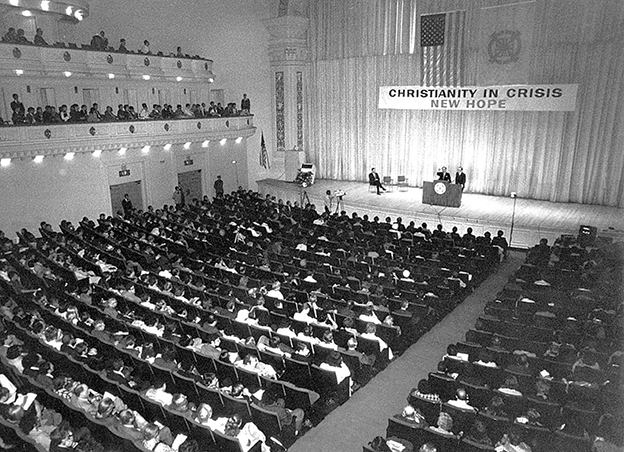
▲ Mr. Moon at Carnegie Hall on October 1, 1973
Moon spoke in Korean, flailing the air and pounding the lectern. It was not easy to follow his message, which was about Adam, Eve, Satan, and the Holy Spirit, linked in a mysterious theology we could not piece together.
Who is this man Moon, and what was the message he wanted us to hear?
Sun Myung Moon was born in what is now North Korea in the village of Kwangju Sangsa Ri [in North P’yŏngan province] on January 6, 1920. His parents were Christians, members of the Presbyterian Church, which is the largest Protestant denomination in Korea.
[According to Michael Breen’s book, Sun Myung Moon, the early years, the Moon family mainly practised shamanism; his sister got possessed by the spirit of a tiger. The Moons converted to Christianity in about 1931. There is no record of them being Presbyterian. As a teenager Moon joined the Jesus Church of Lee Yong-do. see pages 28, 29, 41, etc.]
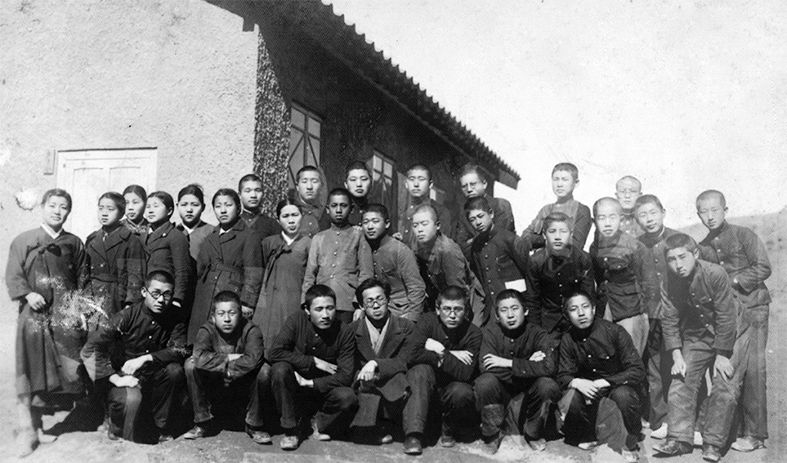
▲ Moon is standing in front of the first window at the Jesus Church in Myungsudae, Seoul.
After attending village primary school Moon was sent to high school in the southern city of Seoul.
On Easter Sunday 1936, when he was 16, Moon had a vision. As he prayed on a mountainside, he relates, Jesus himself appeared and told him “to carry out my unfinished task.” Then a voice from heaven said, “You will be the completer of man’s salvation by being the second coming of Christ.”
[see Moon claimed authority through his “meeting with Jesus.” Moon has told many contradictory versions of this tale.]
The local ground was ready for such ideas. Already there were among some Pentecostal Christians in the underground church in Pyongyang predictions of a new messiah who would be a Korean. As Moon went about his engineering studies at [a Technical High School affiliated with] Waseda University in Tokyo*, he pondered, remembering his vision. In 1944 he returned to North Korea and set about to develop among these Pentecostals a following of his own. In 1946 he founded the “Broad Sea Church.” His followers, it is said, were fanatical people.
* see Hiroshi Yamaguchi’s research on Moon’s academic fraud below.
Meanwhile, in South Korea a man named Kim Paik-Moon [often written as Kim Baek-moon], knowing the prophecy of a Korean messiah, had already taken the obvious next step. Kim considered himself a savior and said so. In Paju, north of Seoul, he had established a community called “Israel Soodo Won” (Israel Monastery), and Moon spent six months there learning what was to become the basis of his own theology, the “Divine Principle,” before returning to Pyongyang.
It was about this time that he changed his original name of Yong Myung Moon to Sun Myung Moon. To many people “Yong” means dragon. “Myung” means shining, and Moon and Sun are understood as in English. Therefore, since 1946 his name has meant Shining Sun and Moon. It savors of divinity and of the whole universe. A name is essential to an Oriental, as revealing one’s character. [ LINK to further details of his name change.]
Now the facts become uncertain. Between 1946 and 1950 Sun Myung Moon spent time in prison in North Korea. The reason? His anti-Communist activities, Moon testifies, reminding us of the rabid Communism of North Korea. Bigamy and adultery, others claim, noting that his real anti-Communist campaign did not take shape until 1962.
In any case, late in 1950 Moon was released and he trekked to South Korea as a refugee with two or three [it was two] disciples. Settling in Busan, he began to propagate his principles. In 1954 he founded his new church [in Seoul], calling it “The Holy Spirit Association for the Unification of World Christianity.”
Moon had gleaned his theological ideas from Kim [Baek-moon and Chong Deuk-eun], and a follower, Yoo Hyo-won [often written as Eu Hyo-won], wrote them down. By 1957 Divine Principle, which proclaims the theology of the Unification Church, was in print. It was first published in English in this country in 1966 and for a second time in 1973. [LINK to further details of where Moon got his theology.]
Divine Principle is concerned with the physical as well as the spiritual salvation of humankind, and the doctrine goes like this:
God intended that Adam and Eve should be perfect and that therefore their children also would be perfect. But Satan entered the Garden of Eden and seduced Eve. By this act she became impure, her blood forever tainted. This taint she passed on to Adam, through their union, and so he too—and their children and all humankind—became forever impure.
God wanted to redeem humanity from this impurity. Therefore, he sent to earth Jesus, the second Adam, and Jesus began the work of redemption. Spiritual salvation he achieved. But God’s will was once again thwarted by Satan. Jesus died on the cross before he could marry and father children. Thus, physical redemption was not accomplished. Our blood is still impure. Now it is time for the third Adam or “the Christ of the second advent.” It is time for the physical redemption of humanity and the reign of the New Israel, Korea.
How will all this come about? Quite simply: the third Adam sent by God to earth—to Korea—will marry a perfect woman, and their children will be the first of a new and perfect world. Eden will return to earth. Heaven will be here, not in some shadowy afterlife.
Does Moon consider himself the new messiah? In the early days of the movement, he admitted that he did. He no longer does so, and his followers are apt to smile when asked what they believe and say, “It is a personal matter.” In the national headquarters of the Unification Church in Washington, however, a votive candle burns beneath a portrait of Moon. Furthermore, in some materials of the Unification Church in Korea there are mythical tales relating that Moon was worshiped by Jesus. Jesus asked Moon to help him complete the saving of humankind and supposedly said, “I have done half, but you can do the other half.”
The half assigned to Moon, of course, involves his fourth and present wife. In the early 1940s Moon was married, but in 1954 this first wife left him because, he said, “she did not understand my mission.” [They divorced in January 1957.] He also is said to have had two other wives [Chong-hwa Kim 1948 and Myung-hee Kim 1955] before marrying in 1960 an 18-year-old [she was 17] high school graduate named Hak Ja Han. At the time of their union (which is called “the Marriage of the Lamb”), he told his followers that she had not yet achieved his own spiritual perfection, but he was confident that she would in time. Together they are the new Adam and the new Eve, the parents of the universe, and their children herald the coming perfection of humanity.
Here reference must be made to “pikareum,” or “blood separation,” which is referred to in Japanese and Korean sources. In this secret initiation rite, it is said that the inner-core members must have intercourse. In the early days of the Unification Church, this was with Moon who, through the act, made pure the initiate. [LINK to Moon’s pikareum theology.]
In 1955 in Seoul Moon was imprisoned briefly and several students and professors were expelled from their universities because of engaging in what were called “the scandalous rites of the Unification Church.”
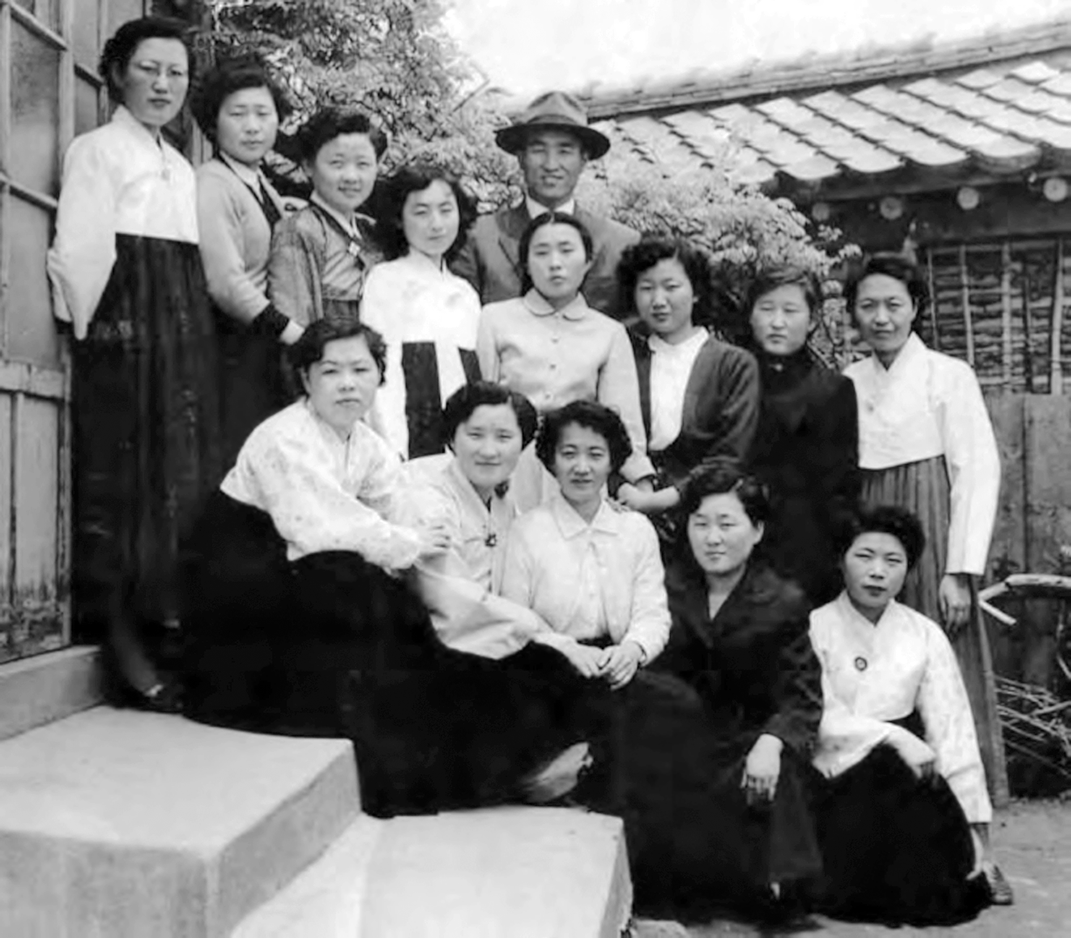
▲ Ewha Womans University professors and students with Sun Myung Moon in about 1955. On the left is Professor Choi Won-bok and standing on the right is Professor Kim Young-oon. They encouraged their students to be “purified” by Moon. Standing in front of Moon is Choi Soon-wha who had an illegitimate son by Moon. LINK to a report on the Ewha sex scandal.
However, in the 14 years since Moon’s marriage to Hak Ja Han, it is not known whether in the secrecy of the initiation ceremony, the rite has become purely a symbolic one. [There have been reports that Moon purified one or three representative wives from some of the mass marriages. See footnote information from Dan Fefferman, a senior UC leader, for further details.]
When asked about this matter of purification, a leader of the Unification Church in the United States replied that purification takes place at the marriage ceremony and that, with special prayers, God’s spiritual blessing and purification are conferred through Moon.
To Moon, Communism is equivalent to Satan. Anti-Communism is the political backbone of his movement.
Both the theology and what were understood as the practices of the Unification Church have been anathema to main-line Christians in Korea. Moon himself was excommunicated by the Presbyterian Church in Korea as long ago as 1948.
His church has not been accepted as a member of either the National Council of Churches or the National Association of Evangelicals in Korea, both of whom state unequivocally that the Unification Church is not Christian.
But Korea is used to offbeat religious movements. There are dozens of splinter sects and “new religions” there. The Unification Church, or Tong-il Kyo, is one of the largest of these with its claimed membership of 300,000 Koreans.
The Unification Church claims a world membership of about a half million. In the United States the number of followers is estimated at about 10,000 so far with between 2,000 and 3,000 core members.
The Unification Church may not be accepted by Korean Christians, but it is openly favored by the present government in Korea, and this sets it apart.
In November 1972 President Park Chung-hee promulgated a new constitution giving himself sweeping power. Christian leaders, among others, mounted effective opposition to it and called for a “democratic” constitution. On January 8, 1974, the president responded by decreeing anyone criticizing the constitution would be tried and, if guilty, imprisoned for up to 15 years.
On February 1, six ministers and evangelists (five Presbyterian and one Methodist) were sentenced to up to 15 years’ imprisonment for their criticism of the constitution. They were judged not by a jury of peers in a civil court, but by a special court-martial at the South Korean Defense Ministry. [ref Christ and Caesar in Modern Korea: A History of Christianity and Politics By Wi Jo Kang, pages 103-104]
Compare Moon, in this context of South Korean politics. Moon started and directs near Seoul a school to which the Korean government annually sends thousands of civilian officials and military personnel for training in techniques of anti-Communism.
In Moon’s view Communism is ideologically equivalent to Satan. Anti-Communism is therefore the political backbone of his movement. Thus he wins the support (which may be in part financial) of the government. At the same time Moon, as a “religious” leader, lends the administration the aura of respectability that all autocracies find useful when, for both home and overseas consumption, it is most needed.
Moon exports to 40 countries the main components of his religious-political movement: the Divine Principle theology with its Korean messiah coupled with vigorous anti-Communism. Chameleonic, the group changes its coloration depending on locale and circumstances.
Sponsors of the International Federation for Victory over Communism, they take on in the United States a quiet title: the Freedom Leadership Foundation. In Japan, however, where they have the support of right-wing groups, they are openly part of the World Anti-Communist League. Here in the United States they sponsor prayer and fasting “for the Watergate Crisis.” In Japan, at the time of Red China’s seating in the United Nations, it was prayer and fasting “for Victory over Communism.”
Everywhere, political involvement is a high priority. The Freedom Leadership Foundation, a Unification Church subsidiary, openly avows its goal of “ideological victory over Communism in the United States.” Gary Jarmin, the 24-year-old secretary-general of the FLF says that they are already spending $50,000 to $60,000 per year trying to influence senators and congressmen on national security issues.
As a nonprofit, tax-exempt organization, FLF is forbidden to lobby for specific legislation, but Jarmin and his seven colleagues in the work don’t hesitate to carry on “educational” programs for legislative aides. Furthermore, Jarmin says, there will soon be a totally separate, new organization that will engage in direct lobbying and openly support political candidates.*
* See John Marks, “From Korea with Love,”
The Washington Monthly, February 1974, page 57
See below for an extract.
The World Freedom Institute is another branch of the FLF’s work, training young people in anti-Communist techniques from an ideological and “religious” point of view. Its International Leadership Seminars are rigorous.
Applicants must pass a preliminary interview. Alcohol and drugs are not permitted, smoking is allowed only at certain times and places, clothing must be clean and neat. All scheduled activities must be attended from 7 a.m. to 9:30 p.m. daily, especially the lectures on Divine Principle, Communism, and Unification thought as a harmony of the Judeo-Christian image of God and the Eastern principle of yin-yang.
For all this, it must be said that political action within the Unification Church is probably limited to a few at center. Moon’s young converts may not be aware of the political side of their movement at all except in the most general terms.
If they wave banners and rally for Nixon, they feel it is because he is ordained by God and given power to be President at this time. Essentially they want to change the moral and spiritual order. They are committed to that, and for them it is enough.
Wherever they go, the Unification Church works to enlist the young. According to those who know the movement in Korea, Japan, and the United States, they are largely the disenchanted young—those whose activism in the ’60s and early ’70s has seemed to bring scant results, those who are turned off by the institutionalized establishment, who are looking for commitment and community, who want not just something but someone to believe in, who want unequivocal answers within a framework of discipline.
There are thousands of young Americans who, in our current retreat from involvement into privatism, fit this description. Moon’s followers are among them. Here in the Unification Church they find instantly a place among their own kind. The hierarchy itself is composed of young people.
The members live in communes that have been set up in most major cities of the country. “It’s like a family,” said one girl who helped establish a new church in Texas. “The whole purpose of the center is based upon God. There’s no premarital sex or drugs or smoking or drinking.” Indeed, Moon thunders against “sexual immorality” as the deadliest of sins.
These are young people who are earnest, sincere, committed, and of high moral character. They are also neat, pleasant, and polite. They are convinced. And they are innocent.
They probably know nothing whatever of Moon’s questionable background or of his strong right-wing political stance. And probably they do not know Christianity well enough (though they study the Bible fervently) to question the theology of Divine Principle. But they have a staunch belief in basic moral values and the possibility and power of spiritual redemption.
If you have not already seen the members of the Unification Church in your town, you will. They have centers in all 50 states and they are busy soliciting both converts and money.
In New York they have reportedly purchased a large old house a few blocks from the Columbia University campus and are offering rooms there for a low rent. They have established an office on the campus under the name of “Collegiate Association for Research of Principles” or CARP (appropriating the traditional Christian symbol of the fish) and at the time of this writing are busy recruiting students for a one-week International Leadership Seminar scheduled for the March recess at the former seminary of the Christian Brothers in Barrytown, New York, which the Unification Church recently purchased.
Some of the Columbia CARP group seem to have had experience in the movement elsewhere. For instance, one young man, a Japanese graduate student, asked a professor at nearby Union Theological Seminary to give him a private crash course in Christianity—something he had not needed for the work in Japan.
To raise money Moon’s followers have so far been selling flowers, home-made candles, bottled arrangements of dried flowers and grasses, and ginseng tea, a herbal tea with medicinal properties.
Everything they earn—everything—goes back to the Unification Church. They claim that when it was necessary to raise $280,000 for a down payment on the Belvedere estate in Tarrytown, the core members across the country dropped everything for eight weeks and did nothing but sell their wares.
Flowers and candles? Yes—and they raised the down payment and more.
In our town on a recent Saturday morning, a young Japanese girl came into a drugstore carrying a small bucket with “Drug Abuse” painted on it in white letters. In her other hand she held bouquets of pink and white carnations wrapped in green wax paper.
“I am Takako,” said the girl. “I am selling these flowers for the One World Crusade. Would you buy some, please?” The high school girl behind the counter looked doubtful but asked, “What is the One World Crusade?”
“Have you heard of the Unification Church?” asked Takako. “We are working against drug abuse.” She held out a paper encased in plastic. At the top in large letters it read: “Immorality/Drug/Abuse/Delinquency/Family Conduct.” Then it introduced Takako and again mentioned the program against drug abuse.
A bystander, a man, asked, “What is this program against drug abuse? I am interested in that myself.”
Takako struggled with English. “You know the Bible?” she asked. “We have meeting and religious education, and we study the secrets of the Bible.”
“But your program against drugs?” the man persisted.
“We work against drugs from the heart,” said Takako. “It is a heart thing, a heart change.”
The man smiled and shook his head. The drugstore owner and a woman customer each bought a bouquet.
This young Japanese girl has left her natural family back in Japan and has come halfway around the world to be part of another family, the Unification Family. This supplants her mother and father, her brothers and sisters. According to Unification doctrine they are impure and imperfect.
She herself, as she is initiated into the Unification Church, will be made pure, and her real family from now on is the group of purified and to-be-purified members like herself. The sadness she has caused (and this sadness is widespread in the homes these young people have left) is of no consequence.
Flowers, candles, tea—where does the real money come from that supports the projects of Moon’s church?
The idea of family is central to Moon’s teaching. The family gives blessing. At the top is the vast human family, then the national family, finally the marital family. One must be in a family to be saved, for the family provides the basic structure for the new Eden.
Most of the young people who join the Unification Church are single. After a period of membership—usually at least three years—they may be married if they have achieved an acceptable spiritual level. Marriages are arranged—a vast improvement, Moon’s followers say, over the chaotic system of personal choice that has destroyed the American family.
The arrangements used to be made by Moon himself, who knew most individual members in the early days and had, it is said, an uncanny gift for sizing up those he did not know. Now, with the growth of the movement, the arrangement of marriages will surely have to be delegated to senior members of the Family.
In 1970 Moon gathered a great group together in Seoul and performed a mass marriage of 777 couples. For those whom he joins, his blessing is a cherished benediction. It carries the notion that Moon himself is the giver of offspring to those he blesses and it makes pure the tainted blood of those who are wed.
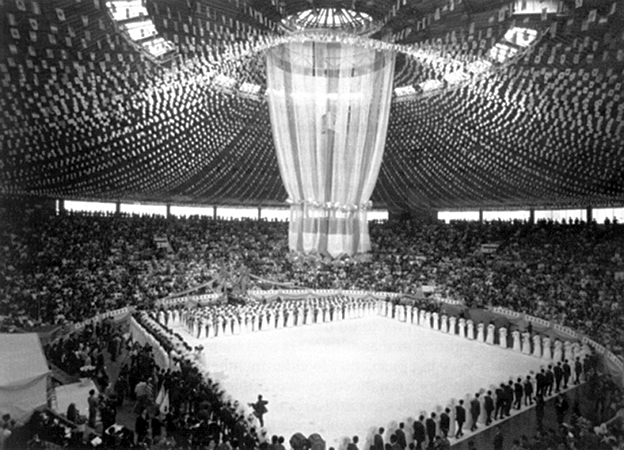
▲ The arrival of the 777 couples.
Where does the money come from that supports the Unification Church? No one seems able to find out.
The Unification Church owns estates, a conference center, and many town houses (such as the handsome one on East 71st Street in New York).
It supports its core members in their work of evangelism, teaching, and preaching at a cost for food, clothing, and shelter conservatively estimated at $5 million per year. It brings hundreds of young Germans, Austrians, Japanese, and Koreans to this country at its expense, not theirs.
It pays for full-page ads in big newspapers. It publishes a tabloid newspaper, books, leaflets. It rents large meeting halls and lecture facilities for its leader to speak in. It invites the country’s leaders to banquets at the best hotels.
Where does the money come from? Not primarily from selling flowers, candles, and ginseng tea, though this effort should not be downgraded or underestimated. The member-businesses (in San Francisco, a printing press; in Denver, a cleaning establishment; in Washington, a new tea house) may swell the coffers but not substantially.
LINK to interview with Japanese former leader
A huge Moon Church scam in Japan is revealed
Moon himself is reputed to be a millionaire, the head of a sizeable conglomerate in Korea that product marble vases, machine parts, ginseng tea, pharmaceuticals, titanium, air rifles and other items. The value of the empire is estimated at $10 to $15 million. Some followers claim that Moon plows the profits back into the Unification Church, but others insist the industries belong to Moon, who has become a very wealthy man.
What outside backing does Moon have? Substantial sums may come from right wing Japanese industrialists and groups that are eager to reestablish the economic power Japan once held over Korea and who consider Moon “their man.” Former Japanese Prime Minister Kishi, leader of the violently anti-Peking faction of the Liberal Democratic Party, is actively associated with Moon’s International Federation for Victory over Communism.
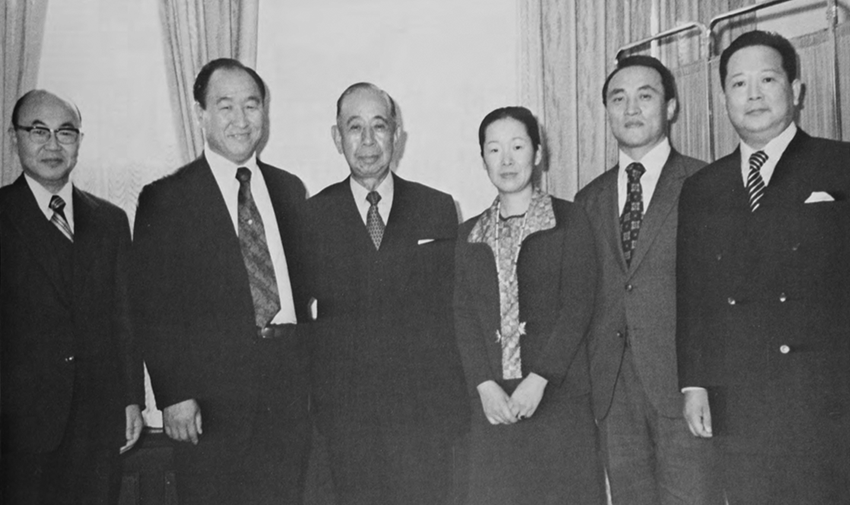
▲ Dr. Lee Sang-hun, Mr. Moon, Kishi Nobusuke, Mrs Moon, Kim Young-whi and Mr Kuboki, leader of the Unification Church of Japan. Dr. Lee Sang-hun wrote ‘Unification Thought’ and ‘Communism, Critique and Counterproposal.’
The big question is: Does the Korean government back Moon? In the article in The Washington Monthly referred to above, John Marks, a student of the CIA in the U.S. and other countries, tackles this question. The Korean CIA, Marks points out, has on occasion secretly subsidized “private” organizations like the Unification Church if they will improve Korea’s image. It would certainly be interested, he says, in a “burgeoning religious-political movement run by a Korean who supports virtually all of the goals and who is in a position to work and lobby for its government’s position on the American political scene.”
Whatever the sources of its money, the Unification Church is in excellent shape financially, and that is very important to it. In Moon’s thinking, money is power and power indicates the blessing of God. God is on the side of power and wealth.
Moon and his followers have come a long way down the road from the mountainside where an earlier messiah, who had nowhere to lay his head, taught his disciples: “Blessed are the poor. Blessed are the meek. They shall inherit the earth.”
Jane Mook is a freelance writer and an occasional contributor to A.D. In addition to mission articles, she has compiled our portfolios of religious art at Christmas and Easter. Her home is in Tenafly, New Jersey.
page 36
Sun Myung Moon’s Front Groups
The Holy Spirit Association for the Unification of World Christianity
The Unification Church
Project Unity
[Project Volunteer]
[Creative Community Project]
International One World Crusade (IOWC)
International Cultural Foundation (ICF)
International Federation for Victory over Communism (IFVOC)
Victory over Communism (VOC)
Collegiate Association for the Research of Principles (CARP)
Freedom Leadership Foundation (FLF)
World Freedom Institute
American Youth for a Just Peace
The Little Angels of Korea
Professors’ World Peace Academy (PWPA)
Committee for Responsible Dialogue
Tong-Il Industry Company
Il-Hwa Pharmaceutical Company
Il-Shin Stoneworks Company
Tong Wha Titanium Company
Tae Han Rutile Company [rutile = titanium dioxide]
2. “From Korea with Love” by John D. Marks
in The Washington Monthly (February 1974)
extract:
“… Sun Myung Moon interweaves politics and religion in the best tradition of the medieval popes. His Unification Church operates a vast network of affiliate organizations in over 40 countries, under the distinctly temporal banner of the International Federation for Victory over Communism. With the formidable task of selling a new messiah to the world, the Moonies (or “the Family” as they call themselves) are extremely media-conscious. Perhaps for this reason the American branch of the Victory over Communism effort has taken on the less strident title of the Freedom Leadership Foundation (FLF).
Political activities in this country are not nearly as developed as those in South Korea, where Moon operates a training school to which the government annually sends hundreds of thousands of civil servants, local officials, and military men for a course in militant anti-communism. Even as other Korean religious leaders have turned increasingly against President Park Chung Hee’s authoritarian rule, Moon has stayed an enthusiastic backer of the regime. Moon’s avowed interest is in fighting communism, not preserving democratic niceties…
Lee Jai-Hyon, who was a top diplomat in South Korea’s Washington embassy until opposition to the Park Chung Hee regime caused him to defect to the U.S. in June, 1973, equates Moon with another Korean messianic leader, Park Tae-Seon, who, Lee says, also raised large sums of money from fanatic believers and grew rich from his business holdings. Lee and his colleagues in the Korean democratic opposition see Moon as an opportunist who has supported the present government in return for personal gain.”
Full article available HERE
Park Tae-seon – another Korean Pikareum Messiah
FBI and other reports on Sun Myung Moon:
1. FBI Report (San Francisco office) on the UC / FFWPU, September 1975
2. Napa Sentinel, March-April 3, 1992 Harry V. Martin and David Caul
“The Moonies – What Rev. Moon teaches the young”
3. Chicago Tribune, Monday, March 27, 1978 James Coates
“The Moonies: Government Files Trace Church from Sex Cult to Korean CIA”
4. New York Times Magazine, May 30, 1976 Berkeley Rice
“The pull of Sun Moon”
United States Congressional investigation of Moon’s organization
Politics and religion interwoven
Moon’s theology for his pikareum sex rituals with all the 36 wives
Sun Myung Moon – Restoration through Incest
Shamanism is at the heart of Sun Myung Moon’s church
How “God’s Day” was established in 1968
The church of Sun Myung Moon is unequivocally not Christian
3. Sun Myung Moon said he went to Waseda University in Tokyo in 1941-1943
47th True Parents Day
Sun Myung Moon
March 29, 2006 Cheongpyeong Heaven and Earth Training Center
Notes: Michael Jenkins (from simultaneous translation)
“You don’t know how powerful and fearful this ideology can be. If the government of Korea had listened to me after the Korean War, the nation would have been saved and the world totally restored in the 1960s and ’70s. I went to Waseda University and studied engineering. I have a profound philosophical framework.”
(http://www.tparents.org/Moon-Talks/SunMyungMoon06/SunMyungMoon-060329.htm)
Sun Myung Moon
November 29, 2011 FFWPU International
Translation of notes taken by the Unification Church History Compilation Committee
“I began [my mission] when I was 27. I had all the details of the principle in my head. There were many thinkers of their time at Waseda University. All the smart ones came to meet me. When I asked them a question they couldn’t answer. Yet, I was able to answer all their questions.”
(http://www.tparents.org/Moon-Talks/SunMyungMoon07/SunMyungMoon-071129.htm)
Sun Myung Moon
January 17, 2011 Hoon Dok Hae Cheon Jeong Gung
“When I was a student of Waseda University, I did not attend class and instead studied Japanese society. I went to university to study electricity but when I asked questions, professors could not answer them.”
Moon told Seon-gil Choi when he was matched to her that he was a graduate from Waseda University. She gave an interview to the Shūkan Post “Weekly Post” magazine in 1993 and spoke about her marriage to Moon.
Despite her unpleasant memories she responded to my questions, one by one, with sincerity. She shared about her first encounter with Sun Myung Moon, and about his relationships with many other women.
She even revealed the interesting story of how those around Moon have misrepresented his academic record as a “graduate from Waseda University” to encourage her to marry him.
Mrs. Seon-gil Choi was born into a wealthy farmer’s family in Jeong-ju, now in North Korea, in 1924. She was 21 when World War II ended. It was around that time that she was presented with an opportunity for a formal introduction to a prospective marriage partner, the 25 year old Sun Myung Moon. He was from the town of Jeong-Ju, the same as her. He was said to be “a graduate from Waseda University.” She related, “A matchmaker arranged the meeting with Moon. There he told me that he had graduated from Waseda University. Also, I had a favorable impression of his appearance, unlike that of now.”
At that time in Korea, it was said that any Korean who had graduated from Waseda University was considered to be among the very elite. According to the brief biography of Sun Myung Moon in the literature of the UC of Japan, it was written that he had been “admitted to the School of Electrical Engineering in the Department of Science and Engineering, at Waseda University.” However, since 1974 his academic record had been reported to have been a fraud.
In response to the claims of fraudulent records, the UC defended the records by saying, “We held an inquiry in Seoul and found that he graduated from an Electrical Engineering course at the Waseda High School of Engineering. It was a simple error on the side of Japan, and Sun Myung Moon should not be blamed.”
However, in our interview, Mrs. Choi testified clearly about her matchmaking meeting with Moon, “He deceived me by saying that he had graduated from Waseda University.” Mrs. Choi found the truth about Moon’s “academic record” many years after her divorce from him. In other words, her testimony proves that what the UC of Japan claimed to be a “simple mistake” was actually proclaimed as the truth by Moon’s followers from the time of his youth, and for a long time after that.”
LINK.
Isamu Kuboki (National leader of Japan for many years) wrote this book:
Rev Moon, a Man of Truth in Danbury. (1989)
page 136: This is Moon’s own response to a question:
私は東京の早稲田大学で電気工学を学びました。
Translated: “I learned electrical engineering at Waseda University in Tokyo.”
4. Evidence that Sun Myung Moon NEVER went to Waseda University
原理運動の素顔
何をする集団なのか その不気味さの実態を衝く (1975年)
山口 浩 (やまぐち・ひろし) 著
“I say it again, Sun Myung Moon was never a student at Waseda University”
from
The Real Face of the Principle Movement
– What is the group doing? Uncovering its creepy reality.
by Hiroshi Yamaguchi (Published August 1975)
From the cover:
What is the Principle Movement?
I think the sight of the mass wedding of 1,800 couples held in Seoul on the 8th of February 1975 is still fresh in your memories, since it was widely reported in the newspapers and other media outlets. Many of you must have heard of the Principle Movement [or Unification Movement] for the first time through this “mass wedding”.
In the course of my research to find the reality of this movement, I was vividly confronted by the horror of how the Principle Movement destroys peaceful families.
So exactly what is the Principle Movement? By getting to the root of this question, I would like to clear up these matters: what are the teachings, what kind of person is the founder Sun Myung Moon, what is the source of the money that supports the Principle Movement, and more.
Chapter 5
The Founder・The Real Face of Sun Myung Moon
pages 135-139
Did Moon really graduate from Waseda University?
In 1941, Sun Myung Moon came over to Japan [on April 1st]. It is said that he smuggled himself into Japan, and that he came to Tokyo after staying in Osaka area for a while working as a construction worker. It is also said that he graduated from the School of Electrical Engineering in the Department of Science and Engineering at Waseda University, but nobody knows when these rumors began to spread.
I guess that he was saying he had graduated from Waseda University at first, and that he withdrew his educational history once the mass media made a big fuss, and the Mainichi Newspaper reported, after checking, that Moon’s name was not on the list of Waseda University graduates.
This photo is not in the book:

▲ The 1943 graduating class of the Technical High School, Electrical Engineering Department. The school was affiliated with Waseda University in Tokyo. The date is given as September 18th in Michael Breen’s book, Sun Myung Moon, the early years. Sun Myung Moon is standing in the center, near the back, indicated with an arrow.
Regarding this point, “The History of the Unification Church” states:
“In 1941, Teacher [Rev. Moon] went to study in Tokyo, Japan, once he had finished his lower secondary education in Gyeongseong.
He was majoring in the Science of Electricity which he studied in lower secondary school, and his educational career has always been in the Science and Engineering field.
In this context, Teacher’s four years studying abroad brought him significant meaning.
Not only in terms of his academic studies, but also in terms of understanding the enemy on the ethnic side (author note: meaning the issue of Japan as the enemy); it brought him both ideological understanding for his providential mission and the ability to take the first steps to challenge Satan’s world, because it was as if he were going into the heart of the enemy. It was a very precious time for him because of this valuable training; he had necessary and important experiences.
In Tokyo, he boarded at 2-Cho-me, Totsuka, Shinjuku ward, near Waseda University, with 2 or 3 Korean students.
In parallel to his schoolwork, there were plenty of things to do during this period. One of his true friends in this period was the architect Deuk-moon Aum 厳徳紋.
What he devoted himself to in this period, with no break, was his life of faith.
International magazines on politics and economics always lay on the top of his desk. Inside the magazines, there were many notes written in coloured pencil.
Also, he carefully associated with Christians. With them the main topic was always his research for the Divine Principle.
He put the highest priority on this, more than anything else. For Teacher, this pursuit for the Principle was the most important topic.”
That was all. As you can see, it only said:
“He boarded at 2 Cho-me, Totsuka, Shinjuku ward, near Waseda University.”
It is not written that he was admitted to Waseda University. Others say that he was admitted to Waseda Jitsugyo High School in Tokyo for night classes after graduating from a junior high school in Osaka, but this a rumor, and the truth is unknown.
What was he doing living at 2 Cho-me, Totsuka?
“Participating in the anti-Japan underground movement with some Korean students,” says “The History of the Unification Church”. In other words, he was in the resistance movement against Imperial Japan, the power of the day.
The book said during that period, in addition to being in the resistance, he fulfilled his life of faith, read the Bible, and studied making notes with coloured pencils. He of course attended church, prayed to God with all his heart, and associated with Christians. If that helps, Deuk-moon Aum, an architect, was named as his friend at school. (In the Church History it does not mention which school Aum was at. It just says ‘a friend at school.’)
However, curiously enough, another citation from a biography written by Kenji Nomura says:
“For the young Moon who went to the Japanese mainland, the six years from 1939 to 1945 was an important time for him to prepare to take official steps toward God’s mission which had been entrusted to him by Jesus. … At that time, though Teacher wanted to be admitted to the Tokyo Imperial University, he was refused from all the national universities because he had already been well-known as a leader of the pro-independence movement. Therefore it was reported that he went on to the faculty of Electrical Engineering at Waseda University, which opened its door most freely to everyone among the private universities.” (October edition of “Shintenchi”)
That is what it said. It is written in a form of transmission as “…was reported”, but in the February (1975) edition of “Shintenchi” it is clearly written:
“Young Moon met Mr. Deuk-moon Aum, a schoolmate from Waseda University, in the street in Busan soon after he arrived there. … Mr. Aum was very good friends with the young Moon. They called each other by their first names.”
As you can see, it is clearly written that Moon was a Waseda University student. Furthermore, it is clearly stated in Mr. Nomura’s writings that he was a schoolmate from Waseda University, though it is not mentioned in which school Deuk-moon Aum was his schoolmate in “The History of the Unification Church.”
Then the Mainichi Newspaper Company checked up, and a news reporter examined the issue. Moreover I checked through the Student Services at Waseda University, and it turned out that they couldn’t find either of the names – 文龍明 [Yong Myung Moon] Ryumei Bun, 江本龍明 Ryumei Emoto or 文鮮明 Sun Myung Moon. Did Moon mean to say that he was enrolled at Waseda University even though his name was not on the list of graduates?
Is there a possibility that he just listened to a few lectures along with some students, because he was living Totsuka, very close to Waseda University? I may sound like I’m repeating myself, but Mr. Nomura wrote:
“When Teacher graduated from University, the graduation was in September, which was six months earlier than usual because the students were required to be drafted to the front because of the war situation. Moon decided to take a ferry line between Shimonoseki and Busan, and he sent a telegram to his home to notify the arrival time, but …”
As you can see, readers, it clearly reported that Moon graduated from Waseda University.
Why on earth did Mr. Nomura, a brain in the Unification Church, state this so clearly even though there was not even a single record of his registration at Waseda University in “The History of the Church” which was published by the church’s Korean head office?
Is it just that Mr. Nomura wanted Moon to be a cool Waseda University graduate? And the world wasn’t sweet enough to just let it pass?
I say it again, Sun Myung Moon was never a student at Waseda University.
Note
Sun Myung Moon was in Japan from April 1, 1941 to just after he graduated from the High School on September 18, 1943. That was a total of 30 months in Japan. He was matched to, or married, Choi Seon-gil in November 1943 back in Korea.
In spite of all the evidence being very clear from at least 1974, the Unification Church of Japan perpetuated the lie the Moon attended Waseda University.
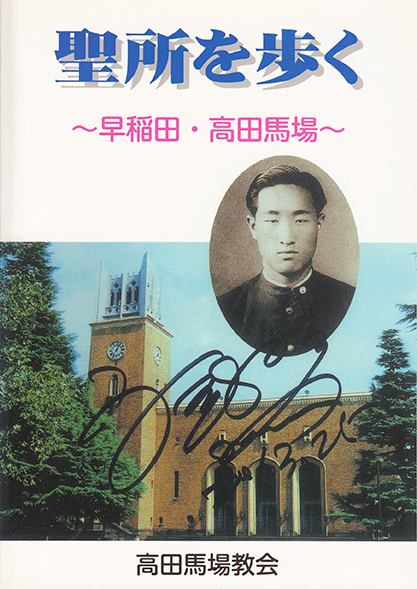
▲ 聖所を歩く, Walking to the Sanctuary / Holy Place.
This book was published by the Japanese UC on October 2, 2000. It shows one of the main Waseda University buildings behind Moon. On page 26 it published the fake Waseda University graduation certificate for Moon shown below.

▲ The Unification Church of Japan even made a fake Waseda University graduation certificate for Moon!
His name is written in the Japanese style, 江本龍明 Ryumei Emoto. Below his name is his birthday, January 6, 1920 (9th year of Taisho). Moon’s date of graduation is given as September 30, 1943 (18th year of Showa). This may have been the graduation date for Waseda University, but it appears not to be the date of Moon’s actual graduation from the Technical High School, which has been given as September 18th. The fake certificate was made on October 18, 1977 (52nd year of Showa).
There is no signature. The name at the end of the certificate is Mr Murai Sukenaka, 村井 資長. He was a president of Waseda University, but he was strongly opposed the Unification Church and CARP.
Mr Murai gave an interview about the Unification Church to a Japanese magazine.
元早大総長が集団結婚を徹底批判 統一教会
This certificate was published in a CARP document about “The history of the Unification Church and the life of Sun Myung Moon 1920-1990” as well as in the book shown above.
The FFWPU is building an internet encyclopedia. Much of the material is taken from Wikipedia and then embellished. And guess what was on the Waseda University page in 2012…
Waseda alumni
“Six postwar Prime Ministers have been Waseda alumni: Tanzan Ishibashi (1956–1957), Noboru Takeshita (1987–1989), Toshiki Kaifu (1989–1991), Keizo Obuchi (1998–2000), Yoshiro Mori (2000–2001), and Yasuo Fukuda (2007–2008). Waseda’s literature program is also well known, and counts Haruki Murakami and Tawara Machi among its graduates. A number of corporate leaders and public figures are also Waseda graduates, including Li Dazhao, co-founder of the Chinese Communist Party; Masaru Ibuka, co-founder of Sony; Lee Kun-hee, chairman of Samsung; Takeo Fukui, CEO of Honda; and Sun Myung Moon, founder of the Family Federation for World Peace and global Unification movements.”
“Notable alumni … Public Life: Sun Myung Moon”
The FFWPU has since removed the false information.
http://www.newworldencyclopedia.org/entry/Waseda_University
Research reveals Moon attended a Technical High School
“Sun Myung Moon the early years, 1920-1953” book by Michael Breen
ISBN 0-9531637-0-9 published in 1997
page 48: “In Tokyo, he [Moon] enrolled in the electrical engineering department of the technical high school.”
page 58: “Classes at the technical high school were in the evenings, between 6pm and 9:30pm, which left him [Moon] free during the daytime.”
page 170: “This point [free during the daytime] was made by Lee Hee-wook in an interview with the author. Lee was in Aum’s architecture class, and in the same lodgings as Moon for one year. Lee said many Korean students worked in offices during the day and could earn forty to fifty won a month.”
Finally the “Waseda graduate” issue is settled in Sun Myung Moon’s ghost-written
Autobiography ISBN 978-1-930549-45-8 May 2010 edition
page 66: “I boarded the Busan-to-Shimonoseki ferry at two o’clock in the morning on April 1. There was a strong wind that night, but I could not leave the deck. I stayed there watching as the lights of Busan became more and more distant. I stayed on deck until morning. On arriving in Tokyo, I entered Waseda Koutou Kougakko, a technical engineering school affiliated with Waseda University. I studied in the electrical engineering department.”
5. Many Unification Church / FFWPU leaders have stated that Sun Myung Moon graduated from Waseda University in Tokyo
Here are some examples:
Won-pil Kim (faithful disciple of Moon since 1946 until his death):
“In the meantime, Father ran into Mr. Duk-moon Aum, an architect, who had been his classmate at Waseda University in Tokyo.”
(http://www.tparents.org/library/Unification/Talks/WPKim/WpKim-781014.htm)
Young-Oon Kim (Perhaps the most respected Unification Church theologian):
In her book “Unification Theology” page 20.
“He had enrolled as an electrical engineering student at Waseda University in Japan.”
Kwang-yol Yoo (Official Unification Church historian):
“After finishing his studies in Seoul, he went to Waseda University in Japan to study electrical engineering.“
(http://www.tparents.org/Library/Unification/Talks/Yoo/SM-Bio74.htm)
Neil Salonen (former US National leader):
“During this time, Rev. Moon studied engineering at a university in Japan.”
Talk given in 1980 on the History of the Unification Church published in the book:
Lifestyle : Conversations with Members of Unification Church ISBN 0-932894-18-6
Antonio L. Betancourt (current senior leader in USA):
“Externally he went to high school and eventually traveled to Japan where he received his degree in electrical engineering at Waseda University.”
(http://www.unification.net/stories/antoniob19991118.html)
Dr Mose Durst (former National leader of USA):
He wrote the book: To Bigotry, No Sanction page 63
“During the years 1941-44 he attended school at Waseda University in Tokyo.”
Tyler Hendricks (current senior leader in USA):
“And I asked myself: what power is it that draws all these Japanese women, from 20 to 70 years old, to True Father? I realized that the answer lies in Father’s college days at Waseda University in Japan. There, as on any campus in any age, there are temptations awaiting every young man and every young woman. Father has testified to how he was tempted by young women in Japan, and how he overcame their temptations. At the same time he was discovering the secret of the fall of man in spirit world. The victory in the spirit world occurred on the foundation of victory over fallen Eve on earth. To win victory over fallen Eve is to liberate fallen Eve. I felt that this power of liberating womanhood explains this powerful standard of devotion on the part of Japanese women to our Father, especially because his victory as a young man going to college took place in Japan.”
(http://www.tparents.org/UNews/Unws9911/Tyler_korea_japan_.htm)
Franco Famularo:
“At the same time, he continued his education in Korea and later in Japan where he studied electrical engineering at Waseda University in Tokyo.”
(http://www.tparents.org/Library/Unification/Books/UcCan/UcCan-0c.htm)
Duk-moon Aum (was at the same school as Moon in Tokyo at the same time – he died 2012):
“Father and I were students in the same year at Waseda University in Tokyo, but Father’s major was engineering and my major was architecture.”
(http://www.tparents.org/Library/Unification/Talks1/Aum/Aum-820600.htm)
Ken Sudo (Senior lecturer at Unification Theological Seminary in the US for many years):
1975 at UTS, Barrytown, New York in a talk given to 120-day trainees
“When he was 19, Father went to Japan where he prepared many things to fulfill his mission. Father went to college at Waseda University in Japan. This university is just like an Ivy League school and is the most prestigious university in Japan.”
(http://www.tparents.org/Library/Unification/Talks/Sudo/Sudo-750000.htm)
Nora Spurgin (senior WFWP leader in USA):
Father said, “I’m going to Japan to attend the university.” He had decided to go to a famous university in Japan called Waseda University.
(http://www.unification.net/history/tphc/tphc-05.html)
Academics have also promoted the myth
Richard Quebedeaux ‘Unity In Diversity – Essays in religion by members of the faculty of the Unification Theological Seminary’ – Edited by Henry O. Thompson (1984)
“In 1938, Sun Myung Moon matriculated at Waseda University in Japan to study electrical engineering, but he continued his strict spiritual discipline while a student and worked with the Korean underground in Japan who were seeking to liberate Korea from Japanese occupation.”
(http://www.tparents.org/UTS/UniDiv/UniDiv-00-03.htm)
J. Stillson Judah wrote this in his introduction to Michael Mickler’s book ‘The Unification Church in America, A Bibliography and Research Guide’ (1987)
page 10: “Rev. Moon studied electrical engineering first in Korea and then for two years in Japan at Waseda University.”
6. Holy Songs – Sun Myung Moon’s face turned red

▲ Kim Deok-jin is on the left in this picture with Sun Myung Moon. For a time the Unification Church of Korea denied that Kim had ever been a member.
Sun Myung Moon understood very clearly the power of music to stir people’s emotions. He exploited the talented Kim Deok-jin to write new songs. At Boonville and other workshop sites music was a powerful means of manipulating the emotions of participants before lectures and other activities.
Pak Chung-hwa (who met Moon in 1949 in the Heungnam prison) was asked to meet a church elder he hadn’t seen for a long time:
“At a coffee shop at the Grand Hotel in Namdaemun, Seoul, I met Kim In-chul, who was then the chairman of the anti-communism association, and some other members. The reason for their calling me was to prevent the action of Kim Deok-jin. They said I was the only one who could persuade him.
At that time Pastor Kim was very earnestly preaching to suspects in jail – or to their victims. As I said before, Kim was good at music and had earlier composed about 20 hymns for the church. Later Eu Hyo-min used those songs and sold tens of thousands of copies in many countries without putting Kim’s name on them. To get his royalties, Kim was going to sue the church.
Pastor Kim was said to have had the pikareum return ritual with Eu Shin-hee and many other women after that. He was planning to publish a book about the pikareum return ritual based on his own experiences. While he was with his lawyer preparing for his lawsuit, they called me to get help. I could understand his feelings, but I persuaded Kim to stop the lawsuit, saying that he could file it anytime. Finally he gave up on the lawsuit.”
from The Tragedy of the Six Marys, Chapter 6
Kim Deok-jin graduated from Sungseol College in Pyongyang. He studied music in Japan and had a career in music throughout his life. He composed 19 well-liked hymns (‘Holy Songs’) for the Unification Church.
This is how he tells his story:
“Moon lived in a small shabby house. I went there and told them that I had a letter from a fellow prisoner. They led me to Sun Myung Moon. We exchanged greetings, then a woman said it was time to lead the service, and she asked me to join the service, so I took part.
It was a very small place and there was nothing much there, not even an organ. The first holy song they sang was called ‘The Return to Paradise’ or something like that. They said that Moon had written the lyrics. It went like this, “After six thousand years of grieving (han), huge battles were fought in search of the laurel wreath of victory.” It was about restoring this world back to the Garden of Eden. For some reason the melody was that of a Japanese military march. I was very surprised and after the service I said something along these lines:
“You are saying you are the living God who will unify the world. How could you sing a ‘Holy Song’ using a Japanese military march, representative of militarism, especially when Japan is the enemy of Korea? It is ridiculous. How can you be the Second Coming Christ?”
I asked him many questions and Moon’s face turned red.
He then asked me to compose some music for other lyrics he had written.
I accepted right away, and I composed ‘Holy Songs’ for the Unification Church for two or three years from then. Sun Myung Moon wrote the lyrics for five songs, Eu Hyo-min wrote the lyrics for one song, and I wrote the lyrics for 13 songs and composed the music for 19 songs in total. They are still sung at Unification Churches throughout the world.
In the Korean ‘Holy Song’ book, my name, Kim Deok-jin, is no longer mentioned as the lyricist or as the composer. They deleted my name. Only in the Japanese ‘Holy Song’ book are there five songs indicated to have been written by Sun Myung Moon and composed by Kim Deok-jin and 14 songs indicate that they had been written and composed by Kim Deok-jin.
Now I must rewind my story a little.
From the day after I visited Sun Myung Moon, beautiful women visited me at the house of my sister. They asked me to join their church. As I was to compose songs, I started to attend the church and they treated me nicely.
It was a time when the church members were making bromide photographs together, and some of them sold these at the Dongdaemun Market. Despite being in this difficult situation they made me several suits, so I enthusiastically composed songs for them.
Eventually, I had no choice but to listen to Moon’s principles. They could be summed up like this: six thousand years ago in the Garden of Eden, a young Eve, who was immature and about the age of a high school girl, was raped by Lucifer, the Archangel Satan. This is the original sin that brought evil into this world….”
from The Tragedy of the Six Marys, Chapter 7
from the UC publication:
Holy Songs – Their Meanings and Historical Backgrounds
International Training Center, Barrytown, New York
Yoko Kobayashi, Song Leader, Education Department, Barrytown
January 1975
HOLY SONGS
1. Blessing of Glory – words: Father
2. Grace of the Holy Garden – words: Father
3. New Song of Inspiration – words: Father
4. Garden of Restoration – words: Father
5. Song of the Victors – words: Father
6. Song of the Spring Breeze – Father heard this when in prison
7. Spring Song of Eden – words: Father
8. Oh, My Little Lambs – traditional Korean Christian hymn
9. The Lord Has Come – Korean Unification Church song
10. My Offering – words and melody: Eu Hyo-min
11. Unite Into One – Korean Unification Church song
12. Call to Sacrifice – Korean Unification Church song
13. Song of the Young People – words: Yoo Kwang-yol
14. Principle Youth March – Korean Unification Church song
15. March of the New Age – Korean Unification Church song
16. Song of the Heavenly Soldiers – words: Mr. David S.C. Kim
17. Unified Soldiers – words: Father; melody – folk tune from Taegu
18. Light in the East – words: Father; melody – regional folk tune
19. Song of Victory – Yuko Kamiyama in Nagoya, February 1962
20. My Promise – words: Hwang Won-jin
21. Suffering and New Life – words: Eu Hyo-won
22. Suffering Jesus – words and melody: Yang Yun-young (f.)
23. Suffering Heart – words: Father
24. Heart of the Father – words: Yi Hong-hi (f.);
.
. melody: Mother’s Heart (a Korean song used in schools)
25. Pledge – words and melody: Yang Yun-young (f.)
26. The Father’s Dwelling Place – Korean Unification Church song
27. Song of the Garden – words and melody: missionary folk hymn
28. Shining Fatherland – words: Lee Wol-sung
29. He Has Called Me – traditional Korean Christian hymn
30. Oh, My Child Come Home Again – traditional Korean Christian hymn
31. Oh Come, My Lord – traditional Korean Christian hymn
32. My Cross – words: Yoo Kwang-yol; melody: Kim Doo-wan
33. When I Behold the Lord – traditional Japanese Christian hymn
34. By the Spring of Life – A traditional hymn in Korea, author not known
35. Day of Glory – words and melody: Yang Yun-young (f.)
36. Song of the Banquet – words and melody: not mentioned
The origins of the melodies of 19 songs are not mentioned in this 1975 UC publication. The authors of 7 lyrics are not mentioned. Kim Deok-jin composed the music for 19 holy songs and the lyrics for 13 of them. Kim states that Moon wrote the lyrics for only five songs at the time he was a member. When Kim left the Unification Church his name was removed from the Korean songbooks as a composer. Later Kim wanted to sue the UC for copyright.
Of the other composers, Eu Hyo-min and music professor Yang Yun-young both left the UC.

▲ Professor Yang Yun-young of Yonsei and Ewha Woman’s Universities. She composed three songs before she left.
Eu Hyo-won left in the last weeks of his life. He had been in hospital for nine months after having been persuaded against his will by Moon to have a risky operation (ref. the testimonies of Eu Shin-hee and Kim Deok-jin and also interviews in the Shūkan Post magazine of October 8, 1993).
Now I have to come to know, I’ve truly come to know, Father, how your heart is filled with tears…
Eu Hyo-min who wrote the song, My Offering, in 1956.
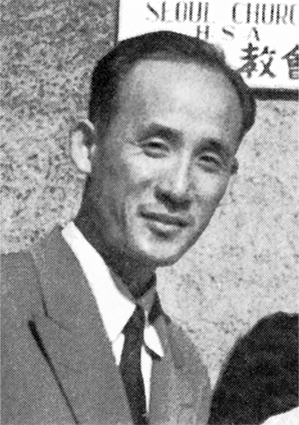
▲ Eu Hyo-min in the early days
He was blessed as one of the 72 couples in June 1962. When many of the 36 couples left the Unification Church, Eu Hyo-min was promoted to the 36 couples to fill a gap. He described the ritual sex, which he himself experienced, that took place in the ceremony. The ceremony for the 72 couples went on for over 11 hours. The UC described it this way:
The 72 Couples Blessing
“This Holy Wedding was held on June 4, 1962. Couples entered the hall in sets of three, and separate ceremonies were held for each set. As the couples entered, a congratulatory poem and song were offered, wedding vows were recited and rings were exchanged. Reverend and Mrs. Moon’s blessing prayer followed, and finally, commemorative photographs were taken. A one hour intermission was held after eight sets of couples had participated in the ceremony. The entire marriage ceremony was completed at 5:30 p.m., more than eleven hours after it had begun!”
Notes from Eu Hyo-min after he left:
Everyday, in the early days of the church, Moon would ask the members, especially the sisters, if they had dreams about him. Moon would then interpret the dreams. The members were very impressed. Eu Hyo-min felt that Moon was really using this technique to get inside the heads of the members.
Moon, in public meetings, asked the sisters if they had sexual dreams about him.
In July 1955 Moon was arrested, along with Eu Hyo-min and four others, because of the Ewha Womans University sex scandal. They all spent time in jail. LINK
In 1972 Hyo-min Eu left the Unification Church.
His cousins were Eu Hyo-won and Eu Hyo-yeong (who were brothers). His younger sister was Eu Shin-hee. They all left the UC. The last to leave was Eu Hyo-yeong who left in 1992.
Eu Hyo-min took many photos in the early days, including the one of Moon kicking his first wife, Choi Seon-gil. After he left the UC he became a successful businessman. Later he contributed to Pak Chung-hwa’s book ‘The Tragedy of the Six Marys’. Eu Hyo-min was interviewed on Japanese national TV about the UC.
According to a friend, he always tried to answer questions truthfully. If he did not know something, he said so.
Eu Hyo-min and Eu Shin-hee, along with others, on Japanese TV
Moon’s first wife, Seon-gil Choi, and Pastor Deok-jin Kim interviewed
https://www.tparents.org/library/unification/Talks/Feffermn/Fefferman-Pekerun.htm
6 or 7 Marys
by Dan Fefferman
[a senior UC leader in the US] January 2, 2001
Question:
Where did the concept of the 3 day ceremony come from? Was it from Pikareum? Two nights the woman on top and the last night the man on top [during sexual intercourse], who came up with this idea I wonder?
Answer:
It certainly seems like it could be the remnant of a more traditional form of pikareum. Especially considering the significance: namely the woman represents the bride of the messiah for the first two nights, and the man represents the restored Adam on the third night.
As to the question of Zin Moon Kim’s [a top Korean UC leader] reported take on this, let me say this:
1. I’ve heard so many versions of the “real story” from different sources, that I certainly don’t accept ZMK’s version as authoritative or complete.
2. I have no way of knowing whether the version of ZMK’s take on this is accurately reported here.
Like I say, I’m sure that with so much smoke on this issue, there must be some fire somewhere. But the exact nature of the fire still is not clear to me. So no, I do not accept ZMK’s reported version of the story as factual. Here are some pertinent facts as I see them.
1. Father was married, and left his wife to go to NK [North Korea] shortly after being involved Baek Moon Kim’s group which MAY have practiced pikareum. [Baek-moon Kim DID LINK]
2. There were charges in NK that Father’s group practiced sexual orgies. These are denied by the UC. [There is strong evidence they did have pikareum sex rituals which Moon leaned from Kim and other Korean messiahs and Moon was jailed for bigamy in 1948 and he was excommunicated by the Presbyterian Church that same year.]
3. After returning to South Korea, Father’s first wife believed him to be involved with other women and divorced him in part because of this. [Two of the women bore illegitimate children, Dong-sook and Hee-jin in 1955. The divorce was in January 1957.]

▲ Sun Myung Moon with Dong-sook, a “True Child.” They look like father and daughter.
4. During their divorce, Father conceived a child with Myung Hee Kim.
5. After this but before marrying mother, Father was arrested on morals charges but was cleared. Park whats-his-name [Pak Chung-hwa] charged that pikareum was used as a witnessing strategy during this time. He later retracted the charge. [The “retraction” was a book written by the Unification Church of Japan, not by Mr Pak.]
6. Some UC husbands believe their wives had sex with Father but no wife that we know of has ever admitted this. [Shin-hee Eu declared on Japanese national TV that she had pikareum sex with Sun Myung Moon LINK.]
7. Some members, reportedly including ZMK (though this is unconfirmed) believe Father had sex with various women representing various ages.
8. Others believe that one sister per blessing was chosen to have sex with him or that he had sex with various women during his first world tour. [He did. He got Soon-wha “Annie” Choi pregnant LINK.]
9. Sammy Pak looks sort of like Father and many people believe he is Father’s son. [He is the son of Moon LINK.]
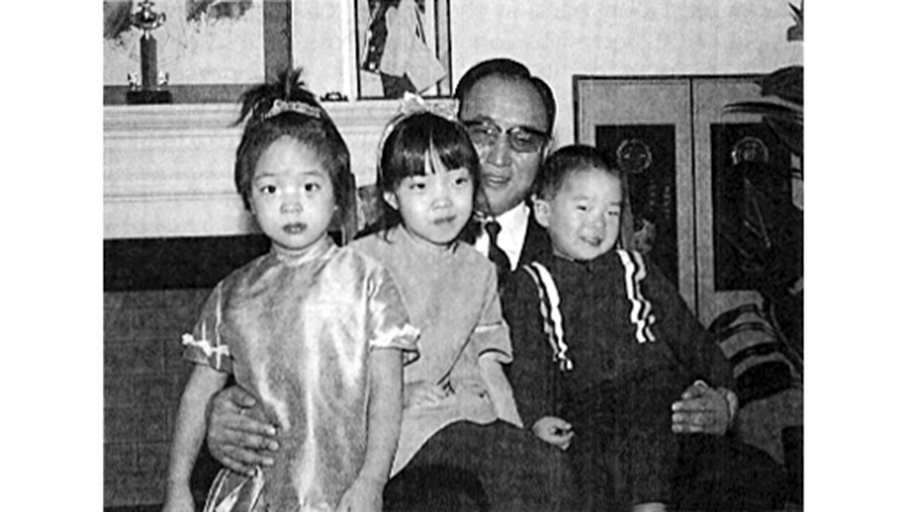
▲ Sam Park sitting on his father’s lap.
10. Father says he never misused his sexual organ, which is not the same thing as saying that he has been entirely monogamous since marrying mother. [Sun Myung Moon and Hak Ja Han married in 1960. Sam Park, illegitimate, was born in January 1966.]
One Japanese wife reportedly bore a son who has made messianic claims as the “fourth Adam” since Moon was supposedly his father. This is known as the Woo Group which is supported by Onni Durst.
Moon’s theology for his pikareum sex rituals with all the 36 wives
Sun Myung Moon – Restoration through Incest
Ritual Sex in the Unification Church – Kirsti L. Nevalainen

